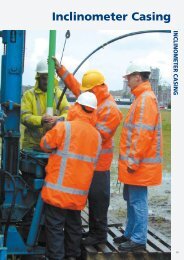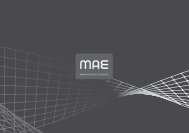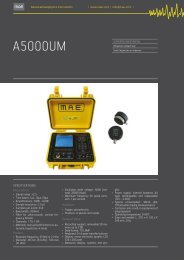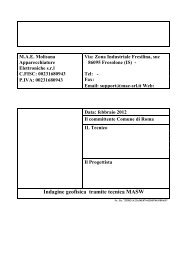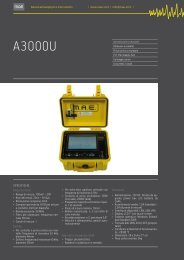Untitled
Untitled
Untitled
Create successful ePaper yourself
Turn your PDF publications into a flip-book with our unique Google optimized e-Paper software.
8<br />
ULTRA SOUNDS<br />
› CONTACT ULTRA-SOUND SURVEYS<br />
(Direct – Indirect – Semi-direct method)<br />
The method is based on the propagation<br />
speed of longitudinal ultra-sonic<br />
waves inside a reinforced concrete<br />
structure. The propagation speeds depends<br />
on the characteristics of the material<br />
such as elasticity, density, presence<br />
of gaps, micro-holes, etc… From<br />
the determination of the following parameters:<br />
reflection, refraction, transit<br />
time (T.O.F.) and mitigation of the vibration<br />
energy, it is possible to obtain information<br />
on:<br />
• Homogeneity of the mix<br />
• Elasto-mechanical characteristics<br />
• Entity, geometry and location of particular<br />
faults or internal defects, variations<br />
in time of the quality parameters<br />
of the concrete<br />
Ultra-sonic tests through which it is<br />
possible to evaluate the transit speed<br />
of the pulses (with known thickness<br />
and time) are particularly important.<br />
The primary goal of the Ultra-sound<br />
survey is to record the time of fly (TOF,<br />
Time of Fly) and the following calculation<br />
of the speed. In order to calculate<br />
the propagation speed of longitudinal<br />
waves (P waves), the arrival of the first<br />
wave-train must be found out with accuracy.<br />
In order to perform this operation<br />
correctly, the instrument must be<br />
equipped with oscilloscope that allows<br />
to visualize the transit wave on the device<br />
display.<br />
The ultra-sound tests can be carried<br />
out with:<br />
• Direct method<br />
When the transmitting and receiving<br />
probes are positioned on the opposite<br />
sides of the element to test.<br />
• Semi-direct method<br />
When the E/R probes are positioned on<br />
adjacent surfaces, usually orthogonal,<br />
of the element to test<br />
• Indirect method<br />
When E/R probes are positioned in the<br />
same side of the structural element to<br />
test.<br />
› CROSS-HOLE ULTRA-SOUND TEST<br />
The cross-hole is a method to analyze<br />
the foundation poles of buildings that,<br />
with the use of ultra-sounds, crosshole,<br />
allow to carry out an accurate<br />
high resolution test. An ultra-sonic<br />
wave is sent from a transmitter to<br />
a receiver, which are convoyed automatically<br />
by the device along the entire<br />
length of the pole inside the pipes<br />
embedded inside of it, during casting.<br />
The speed of the sonic wave and its<br />
energy are strongly influenced by the<br />
quality of the cement. Therefore, it is<br />
possible to assess the characteristics<br />
and give a tomographic representation<br />
in 2D and 3D called diagraphy..



